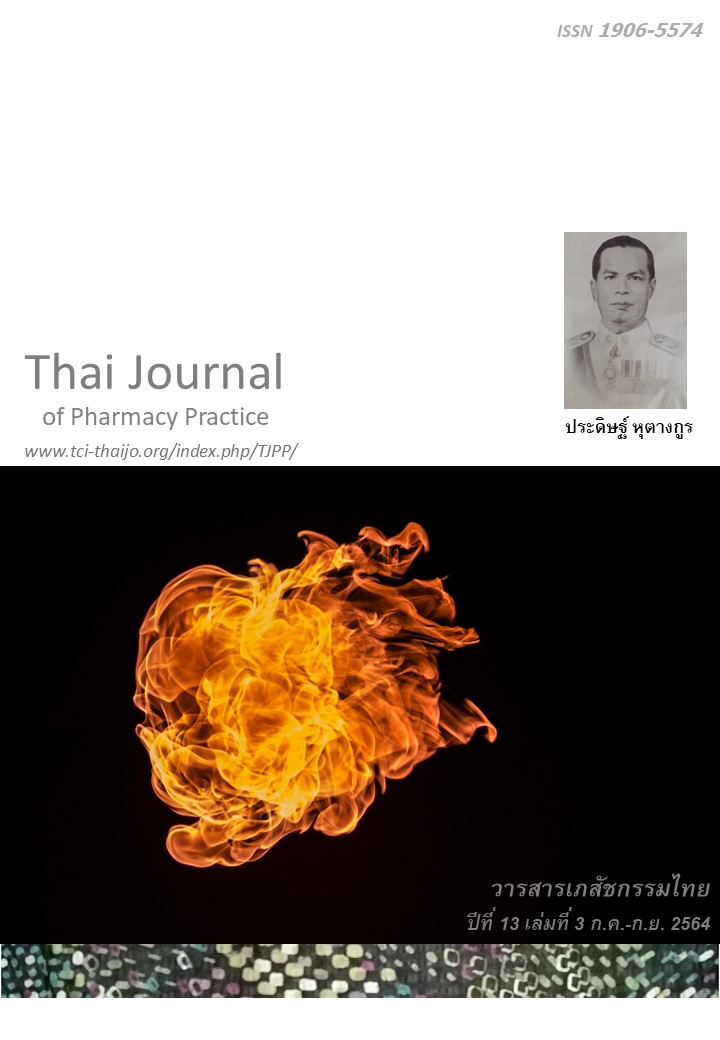คำอธิบายในการตัดสินใจเลือกสั่งใช้ meropenem ของแพทย์ : กรณีศึกษาในโรงพยาบาลแห่งหนึ่งในภาคใต้
Main Article Content
บทคัดย่อ
วัตถุประสงค์: เพื่อศึกษาคำอธิบายการตัดสินใจเลือกสั่งใช้ยา meropenem ตามมุมมองและประสบการณ์ของแพทย์ที่ปฏิบัติงานในโรงพยาบาล วิธีการ: การวิจัยนี้เป็นการศึกษาเชิงคุณภาพโดยการสัมภาษณ์เจาะลึกแพทย์จำนวน 9 คนที่สั่งยา meropenem ไม่น้อยกว่า 10 ครั้งต่อปี ผลการวิจัย: การตัดสินใจเลือกสั่งยา meropenem เกิดจาก 5 เหตุผล คือ 1) ความรุนแรงของโรคติดเชื้อ ได้แก่ ภาวะพิษเหตุติดเชื้อรุนแรง ช็อกเหตุพิษติดเชื้อ เยื่อหุ้มสมองอักเสบ ภาวะพิษเหตุติดเชื้อในหญิงตั้งครรภ์ และอวัยวะล้มเหลวหลายตำแหน่ง 2) ความต้องการผลลัพธ์การรักษาที่ดีขึ้น ทั้งกรณีที่ทราบหรือไม่ทราบผลการทดสอบความไวของเชื้อต่อยา 3) ข้อจำกัดในการใช้ยากลุ่มอื่นซึ่งเกิดจากมีปัจจัยด้านผู้ป่วยและตัวยา 4) ความไม่เชื่อมั่นต่อกระบวนการ และการรายงานผลทางห้องปฏิบัติการจุลชีววิทยา ได้แก่ การเก็บสิ่งส่งตรวจเพื่อเพาะเชื้อ การอ่านผลย้อมสีแกรม การรายงานผลความไวของเชื้อ และ 5) การขาดประสบการณ์ใช้ยาต้านจุลชีพชนิดอื่น นอกจากนี้มีปัจจัยเสริม คือ ความล่าช้าของการรายงานผลเพาะเชื้อ การตัดสินใจของแพทย์ส่วนหนึ่งสมเหตุผลตามหลักฐานเชิงประจักษ์ทางการแพทย์ แต่เมื่อนำมาพิจารณาตามเกณฑ์การใช้ยา meropenem ของโรงพยาบาล กลับพบว่าไม่เหมาะสม ในแง่ของขนาดยา แพทย์ให้ข้อมูลว่า ตนใช้ขนาดยาสำหรับผู้ป่วยที่ติดเชื้อรุนแรงเหมือนกับกรณีผู้ป่วยติดเชื้อไม่รุนแรง คือ ใช้ขนาดพยุง (maintenance dose) 1 กรัม ทุก 8 ชั่วโมง ยกเว้นกรณีการรักษาเยื่อหุ้มสมองอักเสบ ใช้ขนาดยา 2 กรัม ทุก 8 ชั่วโมง ผู้ให้ข้อมูลส่วนใหญ่ไม่ได้ให้ยาขนาดโถม (loading dose) ระยะเวลาในการให้ยาสำหรับการติดเชื้ออื่นที่ไม่ใช่เยื่อหุ้มสมองอักเสบ คือ 7-14 วัน และกรณีเยื่อหุ้มสมองอักเสบเป็น 14-21 สรุป: ผู้ให้ข้อมูลใช้ meropenem เนื่องจากผู้ป่วยมีการติดเชื้อที่รุนแรง และเกรงว่าอาการผู้ป่วยจะแย่ลง โดยใช้ข้อมูลทางคลินิก และผลรายงานทางห้องปฏิบัติการจุลชีววิทยา เป็นพื้นฐานในการตัดสินใจ ผู้วิจัยขอเสนอแนวทางสำหรับผู้บริหารโรงพยาบาลเพื่อสนับสนุนให้มีการใช้ meropenem อย่างสมเหตุผลมากขึ้น ได้แก่ 1) ปรับเกณฑ์การสั่งใช้ยา meropenem ให้มีความชัดเจนมากขึ้น และเป็นเกณฑ์ที่อยู่บนพื้นฐานของหลักฐานเชิงประจักษ์ และข้อมูลความชุกของเชื้อก่อโรค และร้อยละความไวของเชื้อต่อยาของโรงพยาบาลเอง 2) สนับสนุนเครื่องเพาะเลี้ยงเชื้อและตรวจความไวของเชื้อต่อยาอัตโนมัติเพื่อเพิ่มประสิทธิภาพของการรายงานผลทางห้องปฏิบัติการจุลชีววิทยาให้ทันกับการนำไปใช้ในการดูแลผู้ป่วย 3) สนับสนุนทุนการฝึกอบรมเฉพาะทางในสาขาที่เกี่ยวข้องกับการใช้ยาต้านจุลชีพอย่างสมเหตุผลแก่บุคลากรที่เกี่ยวข้อง
Article Details
ผลการวิจัยและความคิดเห็นที่ปรากฏในบทความถือเป็นความคิดเห็นและอยู่ในความรับผิดชอบของผู้นิพนธ์ มิใช่ความเห็นหรือความรับผิดชอบของกองบรรณาธิการ หรือคณะเภสัชศาสตร์ มหาวิทยาลัยสงขลานครินทร์ ทั้งนี้ไม่รวมความผิดพลาดอันเกิดจากการพิมพ์ บทความที่ได้รับการเผยแพร่โดยวารสารเภสัชกรรมไทยถือเป็นสิทธิ์ของวารสารฯ
เอกสารอ้างอิง
Ofori-Asenso R, Agyeman A. Irrational use of medicines-A summary of key concepts. Pharmacy 2016; 4:35. doi: 10.3390/pharmacy4040035.
Van Boeckel TP, Gandra S, Ashok A, Caudron Q, Grenfell BT, Levin SA, et al. Global antibiotic consumption 2000 to 2010: an analysis of national pharmaceutical sales data. Lancet Infect Dis 2014; 14: 742–50.
Katesomboon N, Manomyittikarn T, Limpananon K. Consumption situations. In: Sirisinsuk Y, Pengsu parp T, editors. Drug system situations 2012-2016. Bangkok: Thaidrugwatch; 2018. p. 64–9.
Anon. Antimicrobial resistance, crisis and solutions for Thai society. HSRI Forum 2012; 1: 3–6.
Phumart P, Phodha T, Thamlikitkul V, Riewpaiboon A, Prakongsai P, Limwattananon S. Health and economic impacts of antimicrobial resistant infections in Thailand : a preliminary study. J Health Syst Res 2013; 6: 352–60.
Junkunapas P, Bunyarit P, Prapasoe N, Sreesupan W, Leungreungrong P. AMR hospital management guideline. Nonthaburi: Health Administration Divi sion; 2016.
Høgli JU, Garcia BH, Skjold F, Skogen V, Småbrekke L. An audit and feedback intervention study increased adherence to antibiotic prescribing guidelines at a Norwegian hospital. BMC Infect Dis 2016; 16: 96. doi: 10.1186/s12879-016-1426-1.
Bos JM, Natsch S, van den Bemt PMLA, Pot JLW, Nagtegaal JE, Wieringa A, et al. A multifaceted intervention to reduce guideline non-adherence among prescribing physicians in Dutch hospitals. Int J Clin Pharm 2017; 39: 1211–9.
Ananwattanakit M, Usayaporn S, Tantawichien T, Puttilerpong C, Pengsuparp T. Effects of pharmacist participation in an antimicrobial steward ship program on appropriate antibiotic use. Thai Pharmaceutical and Health Science Journal 2015; 10: 1–9.
Pulcini C, Botelho-Nevers E, Dyar OJ, Harbarth S. The impact of infectious disease specialists on antibiotic prescribing in hospitals. Clin Microbiol Infect 2014; 20: 963–72.
Barlam TF, Cosgrove SE, Abbo LM, MacDougall C, Schuetz AN, Septimus EJ, et al. Implementing an antibiotic stewardship program: guidelines by the infectious diseases society of America and the society for healthcare epidemiology of America. Clin Infect Dis 2016; 62: 51–77.
Lew KY, Ng TM, Tan M, Tan SH, Lew EL, Ling LM, et al. Safety and clinical outcomes of carbapenem de-escalation as part of an antimicrobial steward ship programme in an ESBL-endemic setting. J Antimicrob Chemother 2015; 70: 1219-25. doi: 10.1093/jac/dku479.
National Drug System Development Committee. National list of essential medicines [online]. 2018 [cited Sep 21, 2019]. Available from: www.fda.moph .go.th/sites/drug/Shared%20Documents/New/nlem2561.PDF
Farsad BF, Hadavand N, Kopaiee HS, Shekari F. Carbapenems, linezolid, teicoplanin utilization evaluation in a large teaching based hospital (Sha hid Rajaie Heart Center, Tehran): A quality improve ment study. Biomed Pharmacol J 2016; 9: 525–32.
Salehifar E, Shiva A, Moshayedi M, Kashi T, Chabra A. Drug use evaluation of meropenem at a tertiary care university hospital: A report from Northern Iran. J Res Pharm Pract 2015; 4: 222-25.
Sanhoury OM, Eldalo AS. Evaluation of meropenem utilization in intensive care unit in Sudan. Int J Clin Pharmacol Pharmacother. 2016; 1: 106. doi:10.153 44/2456-3501/2016/106
Kaengklang S. Drug use evaluation of parenteral imipenem/cilastatin, meropenem, cefoperazone/sul bactam, piperacillin/tazobactam and levofloxacin for in-patient at Nongkhai hospital [master thesis]. Khon Kaen: Khon Kaen University; 2011.
Holloway KA. Promoting the rational use of antibiotics. Regional Health Forum 2011; 15: 122–30.
Leekha S, Terrell CL, Edson RS. General principles of antimicrobial therapy. Mayo Clin Proc 2011; 86: 156–67.
Dugar S, Choudhary C, Duggal A. Sepsis and septic shock: Guideline-based management. Cleve Clin J Med 2020; 87: 53–64.
Rhodes A, Evans LE, Alhazzani W, Levy MM, Antonelli M, Ferrer R, et al. Surviving Sepsis Campaign: International Guidelines for Manage ment of Sepsis and Septic Shock: 2016. Intensive Care Med 2017; 43: 304–77.
Hussein K, Bitterman R, Shofty B, Paul M, Neuberger A. Management of post-neurosurgical meningitis: narrative review. Clin Microbiol Infect 2017; 23: 621–8.
Kim B-N, Peleg AY, Lodise TP, Lipman J, Li J, Nation R, et al. Management of meningitis due to antibiotic-resistant Acinetobacter species. Lancet Infect Dis 2009; 9: 245–55.
Moraes RB, Guillén JAV, Zabaleta WJC, Borges FK. De-escalation, adequacy of antibiotic therapy and culture positivity in septic patients: an observational study. Rev Bras Ter Intensiva [online]. 2016 [cited Apr 14, 2020]. Available from: www.gnresearch. org/doi/10.5935/0103-507X.20160044
Paul M, Dickstein Y, Raz-Pasteur A. Antibiotic de-escalation for bloodstream infections and pneumonia: systematic review and meta-analysis. Clin Microbiol Infect 2016; 22: 960-7. doi: 10.1016/ j.cmi.2016.05.023.
Udy AA, Roberts JA, Lipman J. Clinical implications of antibiotic pharmacokinetic principles in the critically ill. Intensive Care Med 2013; 39: 2070–82.
Yuson CL, Katelaris CH, Smith WB. Cephalosporin allergy label is misleading. Aust Prescr 2018; 41: 37–41.
Udy AA, Roberts JA, Lipman J. Clinical implications of antibiotic pharmacokinetic principles in the critically ill. Intensive Care Med 2013; 39: 2070–82.


